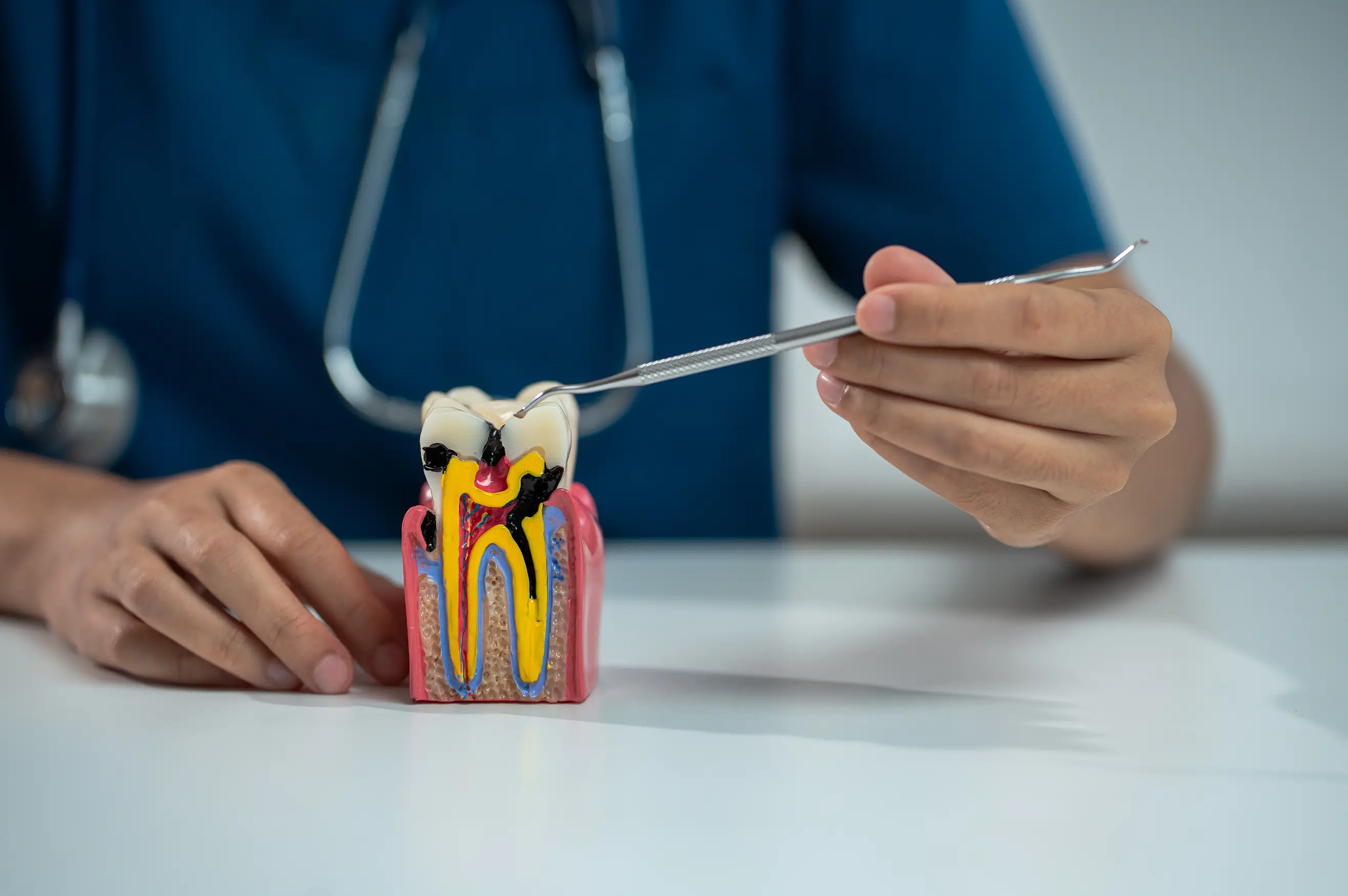Dead Tooth Nerve: Causes, Symptoms, and Treatment
Dead Tooth Nerve: Causes, Symptoms, and Treatment
Learn what a dead tooth nerve is, its causes, symptoms, treatment options, and how long a dead tooth can stay in your mouth before it causes serious problems.
Table of Contents
- What Is a Dead Tooth Nerve?
- What Causes a Tooth Nerve to Die?
- Symptoms of a Dead Tooth Nerve
- What Does a Dead Tooth Nerve Look Like on an X-Ray?
- Can a Dead Tooth Cause Pain?
- Can a Dead Tooth Kill You?
- How Long Can a Dead Tooth Stay in Your Mouth?
- Is a Root Canal on a Dead Tooth Painful?
- Dead Tooth Nerve Treatment Options
- Preventing Tooth Nerve Death
- Frequently Asked Questions
What Is a Dead Tooth Nerve?
A dead tooth nerve refers to a tooth whose internal nerve tissue — called the pulp — has died. The pulp sits inside the tooth and contains blood vessels and nerves that keep it alive. When that pulp dies, the tooth is no longer “living” and may eventually darken, become brittle, or cause pain and infection.
Even though the outer enamel remains intact, a dead tooth can no longer sense temperature or pressure. The loss of blood flow and nerve supply causes the tooth structure to slowly weaken, making it vulnerable to decay and bacterial invasion.
Dentists often use the term “non-vital tooth” to describe this condition. While a dead tooth may not hurt at first, it can still lead to complications if left untreated.
What Causes a Tooth Nerve to Die?
There are two primary causes of a dead tooth nerve: trauma and tooth decay.
1. Dental Trauma
A strong impact — like from a fall, sports injury, or accident — can rupture the blood vessels inside the pulp. Without circulation, the nerve tissue inside begins to die. Sometimes, the tooth may look fine externally but gradually darken over months or years as the inner tissue decomposes.
2. Untreated Tooth Decay
When cavities are ignored, bacteria eat through the enamel and dentin until they reach the pulp. The body’s immune system tries to fight the infection, but pressure builds inside the tooth, cutting off blood flow to the nerve. Eventually, the pulp tissue dies, and the bacteria can spread to the root tip, leading to an abscess — a painful pocket of pus in the gums or jawbone.
Symptoms of a Dead Tooth Nerve
Recognizing the signs of a dying or dead tooth can help you seek treatment before the infection spreads. Common dead tooth nerve symptoms include:
-
Discoloration: A dead tooth may turn yellow, gray, or black as the internal tissue breaks down.
-
Pain or Sensitivity: Some people feel throbbing or sharp pain, especially when chewing or exposed to hot and cold temperatures.
-
No Pain at All: In some cases, there’s no pain because the nerve is completely dead — but infection may still be present.
-
Swelling or Gum Tenderness: A small pimple or swelling near the affected tooth may indicate an abscess.
-
Bad Smell or Taste: A decaying nerve can produce a foul odor or unpleasant taste due to bacterial buildup.
-
Tooth Mobility: In severe cases, the dead tooth can feel loose as the surrounding bone deteriorates.
Even if you’re not in pain, any tooth discoloration, swelling, or persistent bad taste should be checked by a dentist.
_1762436291.webp)
What Does a Dead Tooth Nerve Look Like on an X-Ray?
Dentists confirm a dead tooth nerve using dental X-rays or vitality testing. On an X-ray, a dead tooth may show:
-
A dark area near the root tip, indicating infection or bone loss.
-
Changes in the pulp chamber, which may appear narrower or completely calcified.
-
Possible signs of an abscess — a shadow or dark halo around the root.
Your dentist might also perform a pulp vitality test using temperature or electrical stimuli to see if the nerve responds. A non-responsive tooth typically indicates nerve death.
Can a Dead Tooth Cause Pain?
Yes — but not always. A dead tooth nerve might cause intense pain while dying, due to inflammation and pressure buildup inside the pulp. Once the nerve completely dies, the pain may disappear temporarily, leading people to think the problem resolved itself.
However, bacteria can continue multiplying inside the dead tooth, eventually causing infection, swelling, and severe pain as the surrounding tissues become inflamed. This delayed reaction is one reason why even a painless dead tooth still requires treatment.
Can a Dead Tooth Kill You?
It’s extremely rare, but an untreated dead tooth can lead to life-threatening infections if bacteria spread beyond the mouth. When a tooth abscess is ignored, the infection can travel through the bloodstream to the jaw, neck, or even brain — a condition called sepsis.
While modern dentistry makes this outcome uncommon, it underscores why you should never leave a dead tooth untreated. Early intervention can prevent serious complications.
How Long Can a Dead Tooth Stay in Your Mouth?
Technically, a dead tooth can remain in your mouth for years — especially if it’s not causing pain. However, this is not recommended. A dead tooth gradually becomes brittle, prone to breaking, and serves as a breeding ground for bacteria.
Even if it looks fine externally, the hidden infection can silently damage surrounding bone and tissue. Most dentists advise either saving the tooth with a root canal or removing it to avoid long-term issues.
Is a Root Canal on a Dead Tooth Painful?
A root canal treatment is the most common and effective way to treat a dead tooth. Contrary to popular belief, the procedure is usually painless, as the nerve inside the tooth is already dead.
Here’s what happens during a root canal:
-
The dentist makes a small opening in the tooth.
-
The dead nerve and infected pulp are removed.
-
The canal is disinfected, filled, and sealed.
-
A crown is placed to restore strength and appearance.
Most patients feel relief within a few days, and the treated tooth can last 10 to 15 years or more with proper care.
Dead Tooth Nerve Treatment Options
Treatment depends on the severity of damage and infection:
-
Root Canal Therapy: Removes the dead pulp and saves the tooth structure.
-
Tooth Extraction: Recommended if the tooth is too damaged to repair.
-
Internal Bleaching: For discolored teeth, a whitening agent can be applied from inside after a root canal.
-
Dental Crown or Veneer: Restores the tooth’s function and appearance.
Your dentist will evaluate whether saving the tooth is feasible. In most cases, preserving a natural tooth is preferred over extraction.
_1762436342.webp)
Preventing Tooth Nerve Death
You can prevent a tooth nerve from dying by practicing consistent oral hygiene and protecting your teeth from trauma:
-
Brush twice a day and floss daily.
-
Visit your dentist for cleanings every six months.
-
Treat cavities early before they reach the pulp.
-
Wear a mouthguard during sports or teeth grinding (bruxism).
-
Avoid using your teeth to open packages or bite hard objects.
Preventive care is always easier — and less expensive — than treating a dead tooth later.
Frequently Asked Questions (FAQ)
I’ve had a dead tooth for years. Should I be worried?
Yes. Even if it’s not painful, bacteria may still be present. It’s best to have a dentist examine it with an X-ray to check for hidden infection.
Can a dead tooth smell bad?
Yes. As the nerve tissue decays, bacteria release foul-smelling compounds that can cause bad breath or a bad taste.
What does a dying tooth feel like?
You may feel dull, throbbing pain, sensitivity, or a feeling of pressure that fades as the nerve dies.
Can a dead tooth be whitened?
Traditional whitening doesn’t work well. However, internal bleaching or a veneer can restore a natural color.
Can a dead tooth heal on its own?
No. Once the pulp dies, it cannot regenerate. Professional treatment is necessary to prevent infection.
The Bottom Line
A dead tooth nerve may not always hurt, but it’s far from harmless. Whether caused by trauma or decay, the dying nerve leaves the tooth vulnerable to infection and decay. Early diagnosis and treatment — usually through a root canal or extraction — can prevent pain, bone loss, and serious health risks.
If you notice discoloration, swelling, or a bad smell, don’t wait for pain to appear. Schedule a dental checkup right away — saving your smile could also protect your health.
Sources
- Medical News Today. Dead tooth: Symptoms, causes, and treatment.
- https://www.medicalnewstoday.com/articles/319062
- Colgate. Dead Nerve in a Tooth: Causes and Treatment.
- https://www.colgate.com/en-us/oral-health/root-canals/dead-nerve-in-a-tooth-causes-and-treatment
- Healthline. Dead Tooth: Signs, Symptoms, and Treatment.
- https://www.healthline.com/health/dental-and-oral-health/dead-tooth
Fill it out to get your free consultation
Innovation & Precision In Every Implant
We use only reputable, high-quality implants designed for long-term durability
BioTec Dental Implants


Hiossen Dental Implants


Straumann Dental Implants


Nobel Biocare Dental Implants


MegaGen Dental Implants








